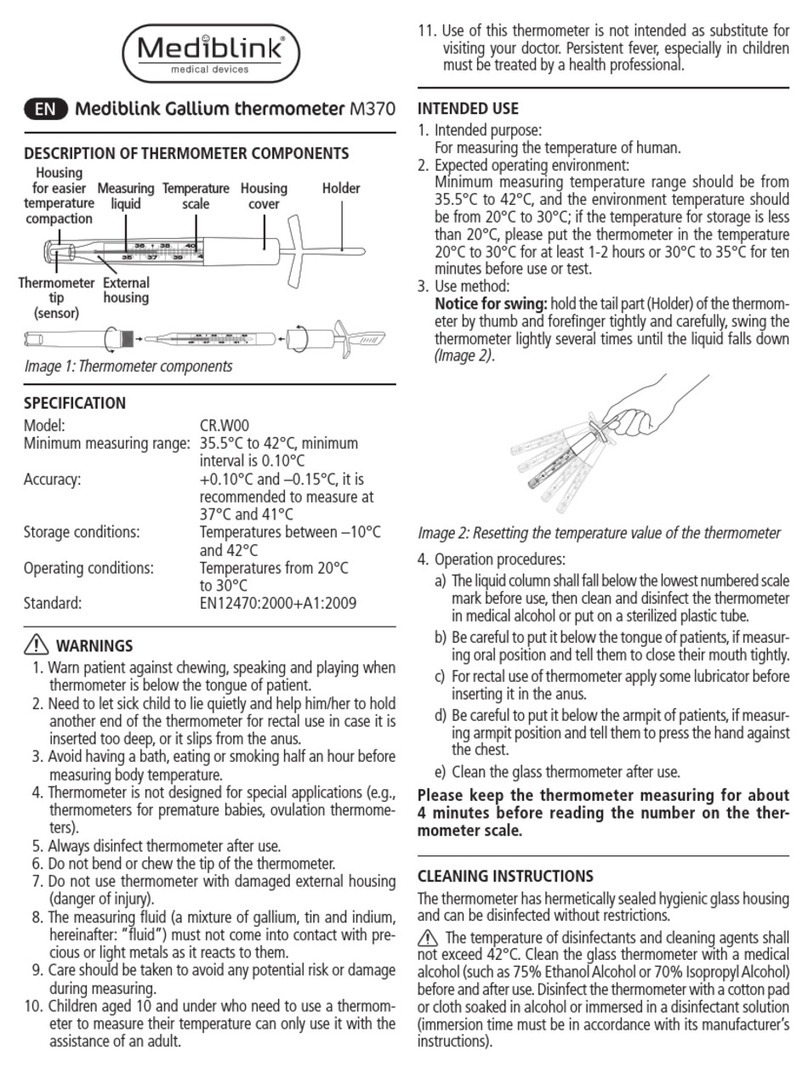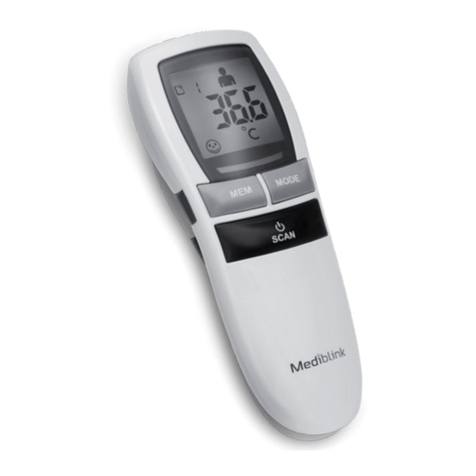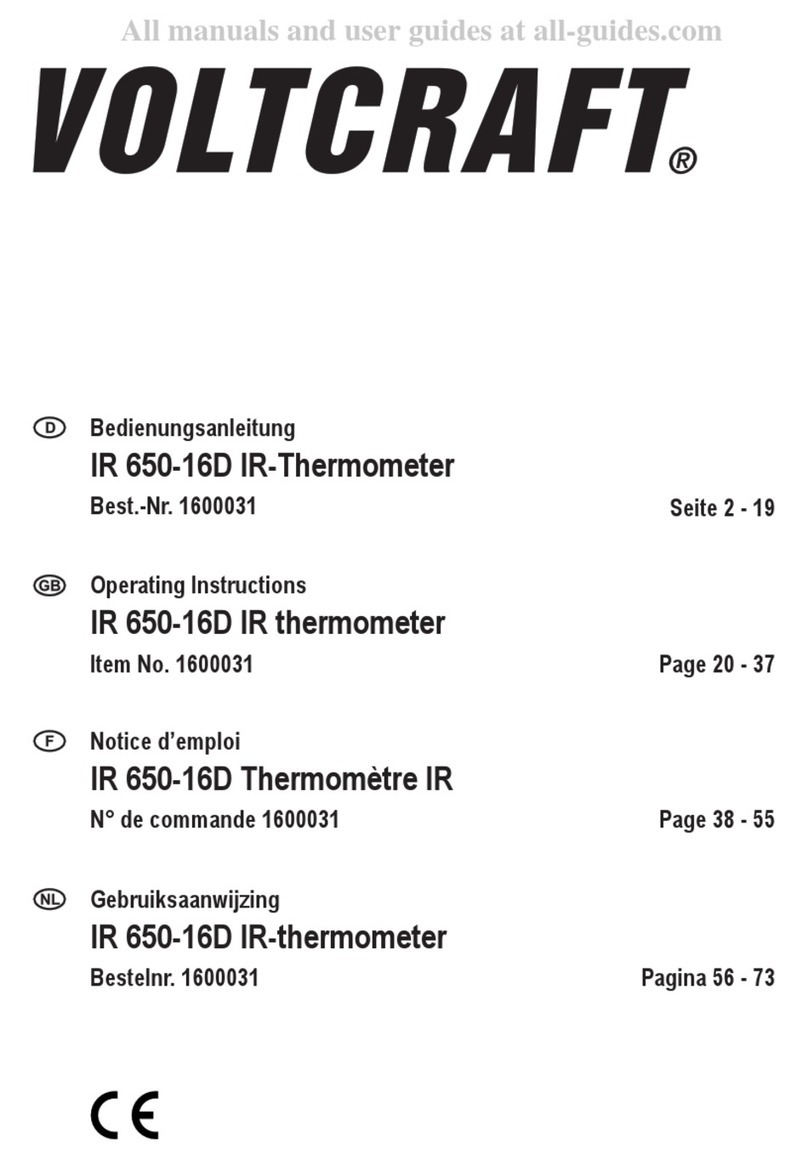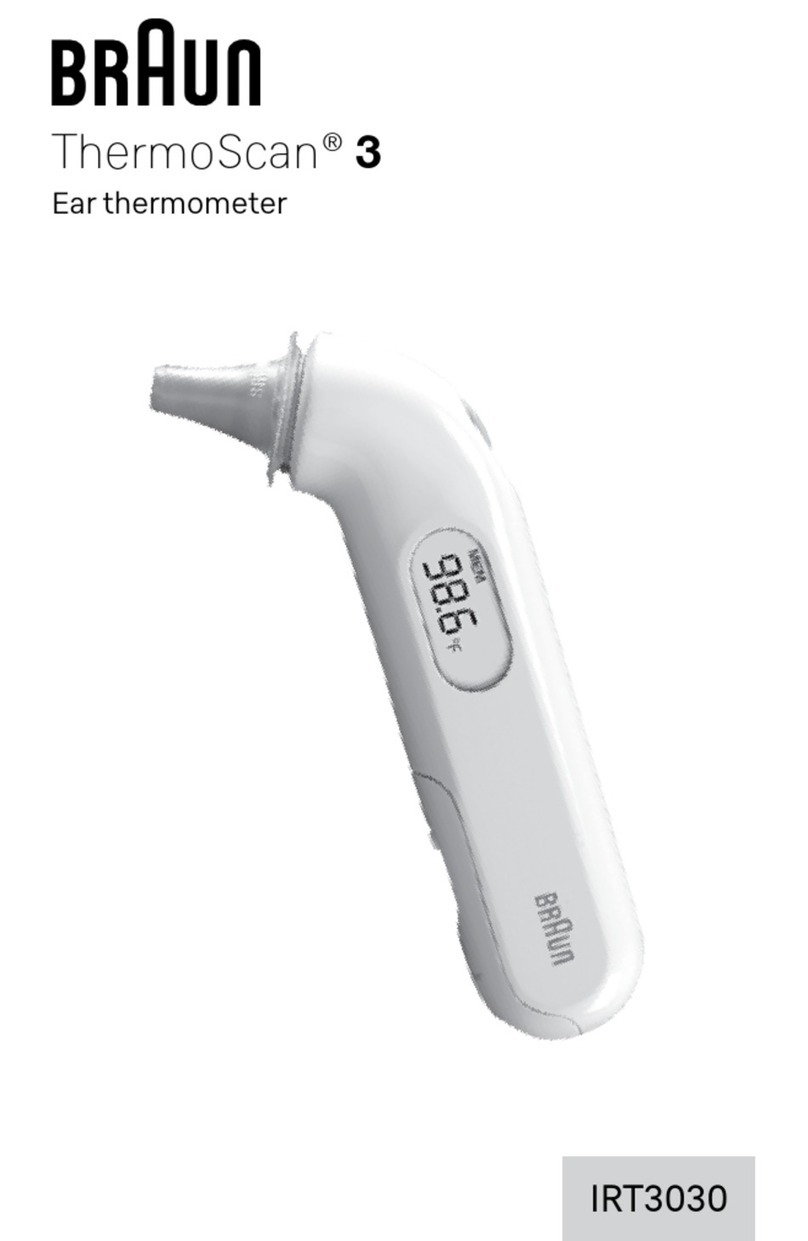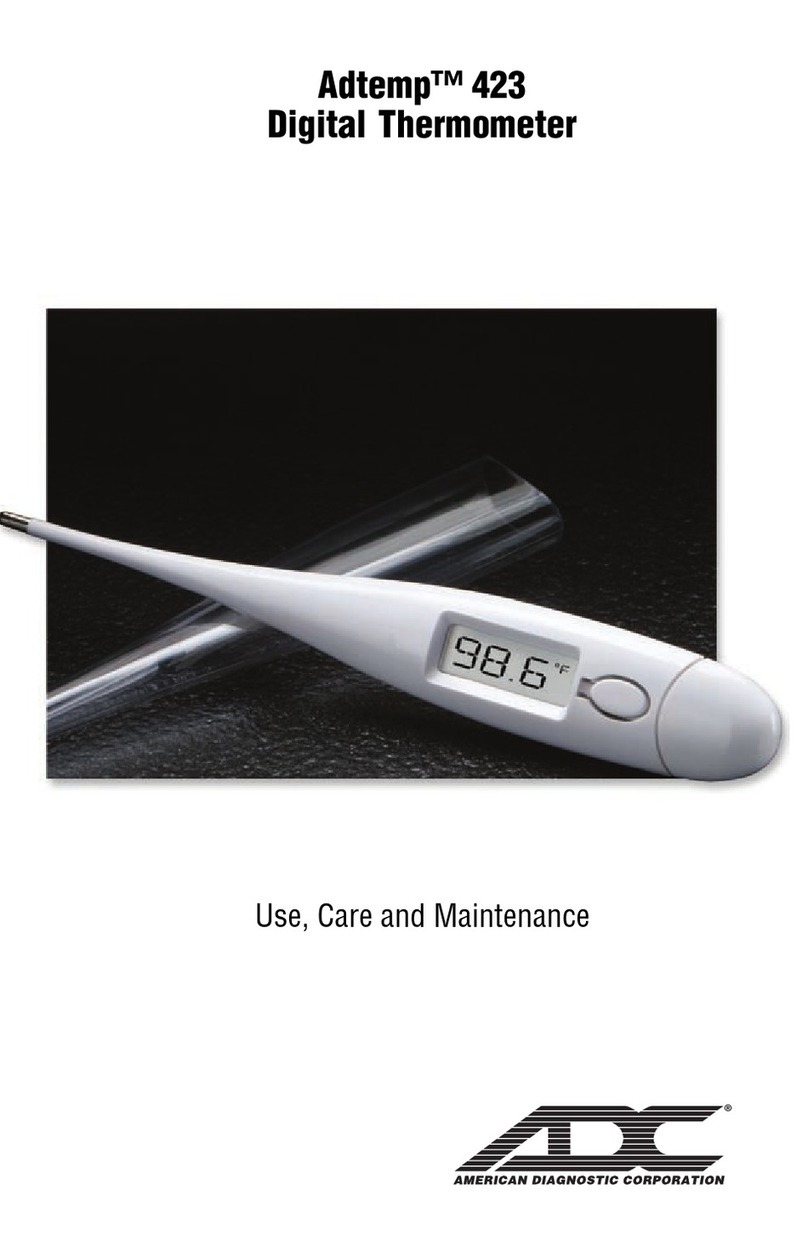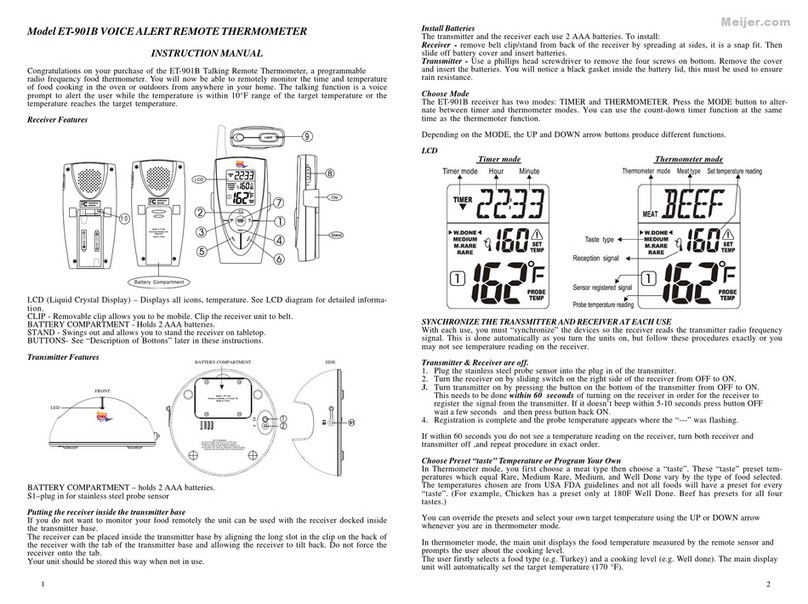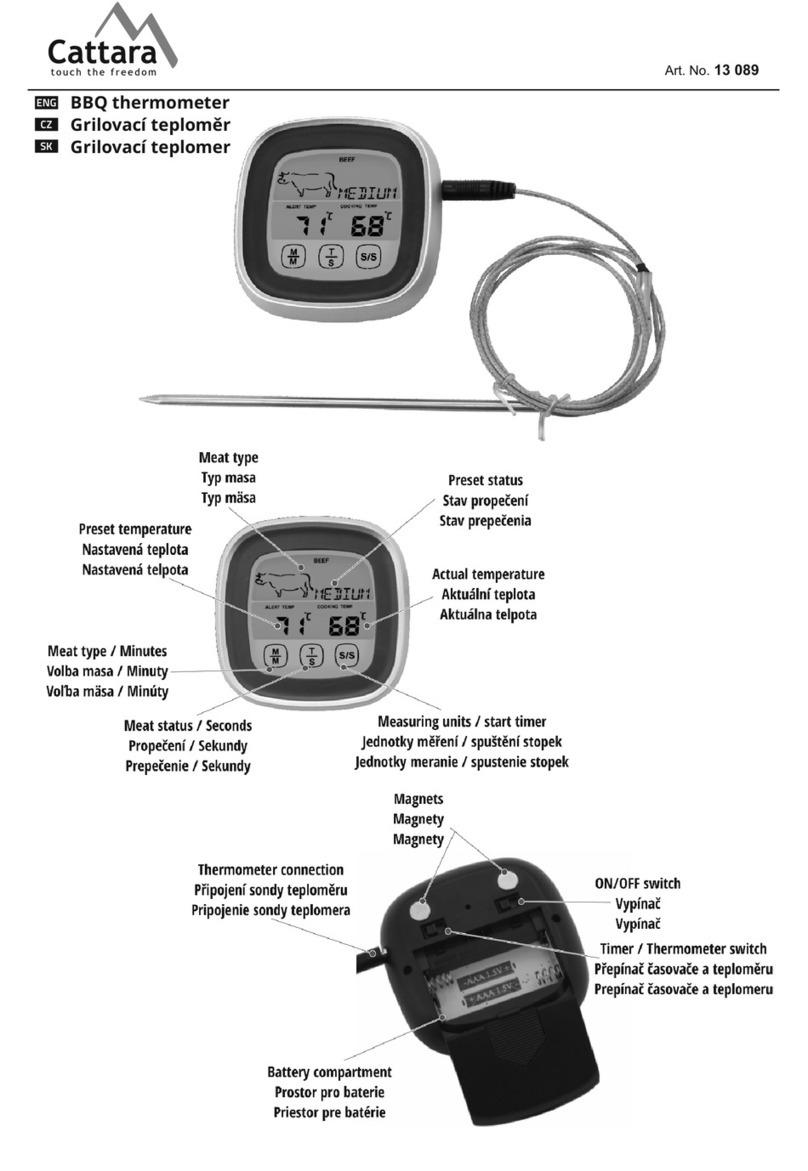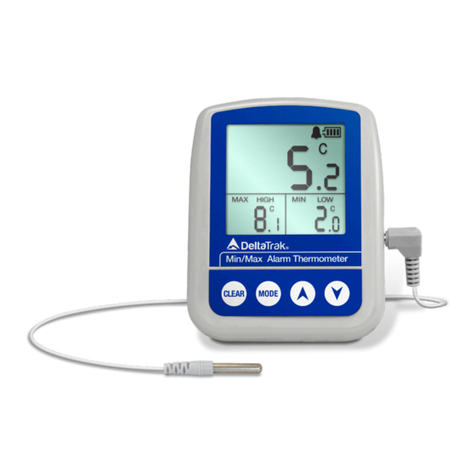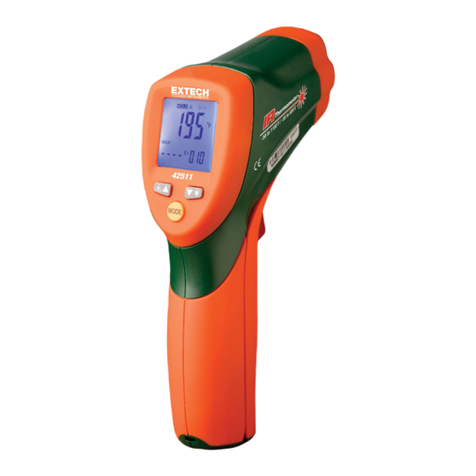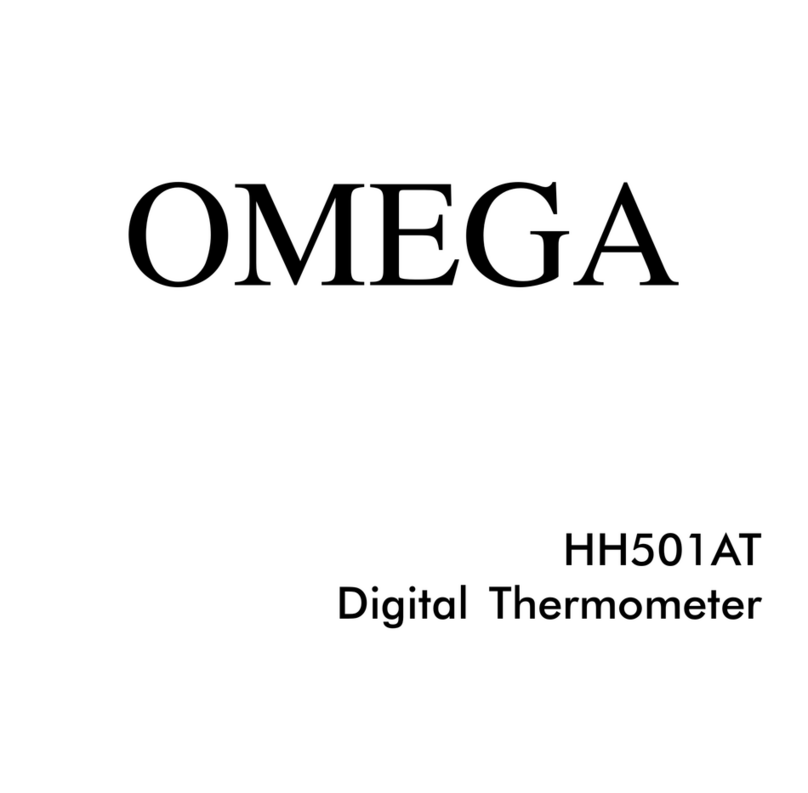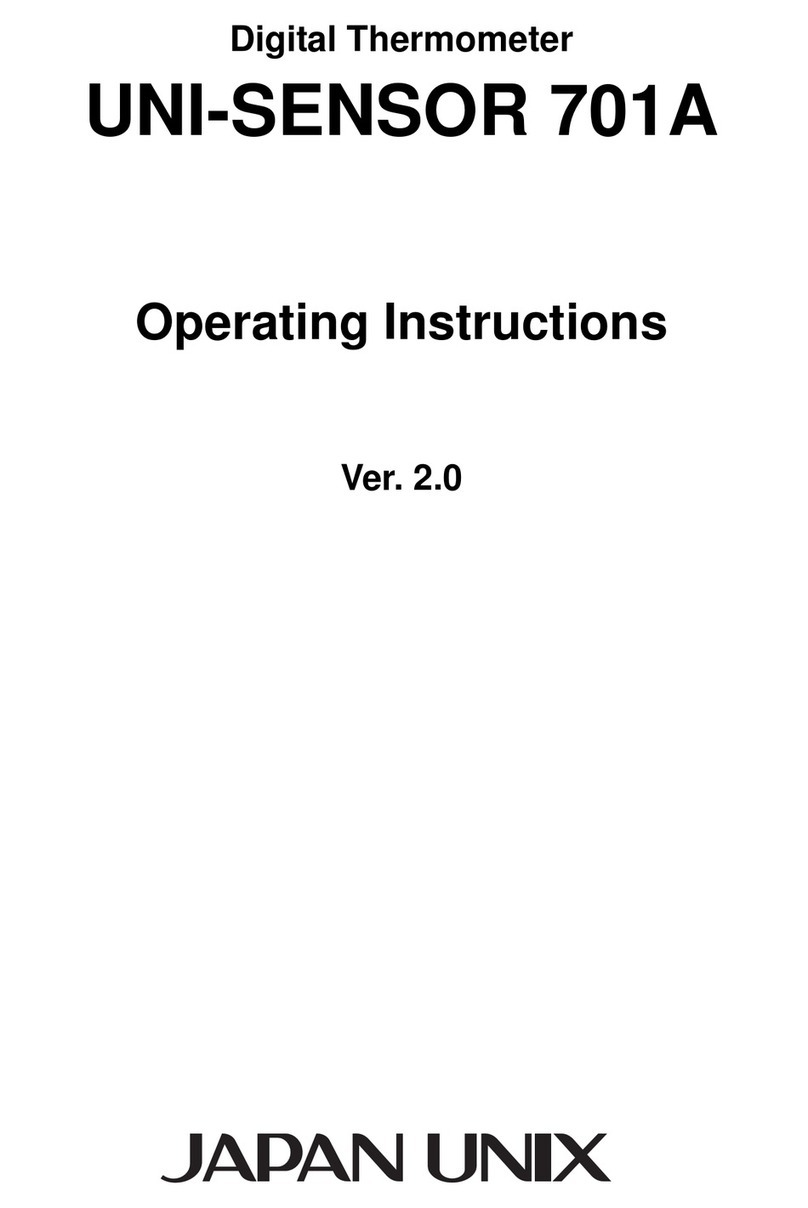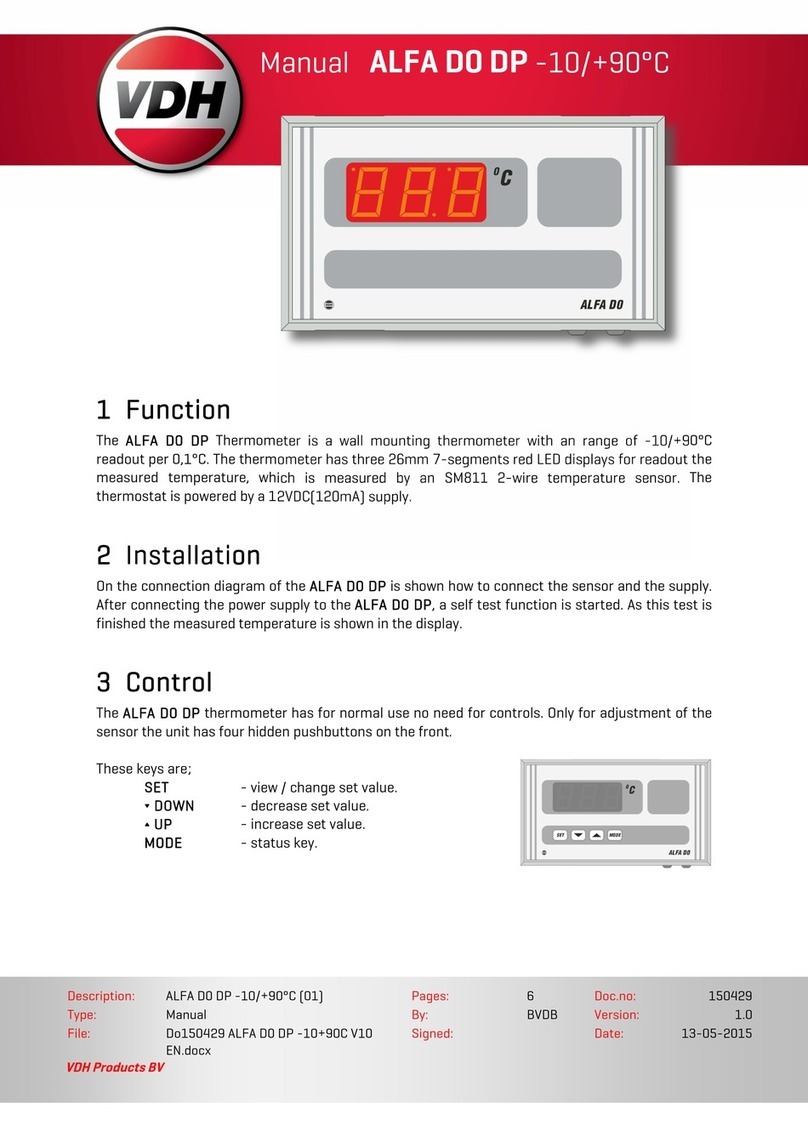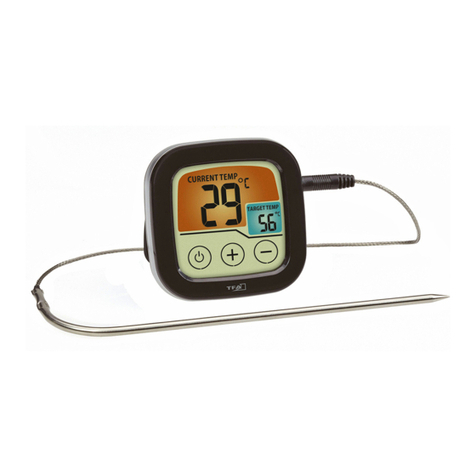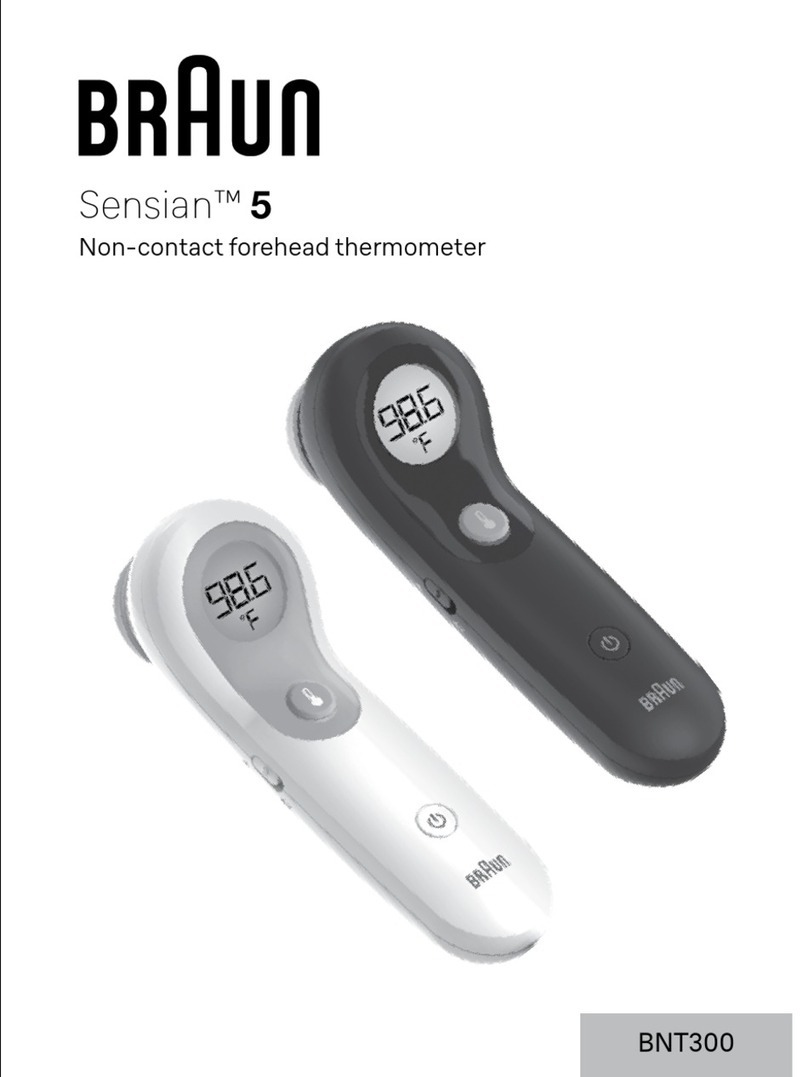Mediblink M300 User manual

ENG Mediblink Ear Thermometer M300
ENG
INSTRUCTIONS FOR USE
PLEASE READ THE INSTRUCTIONS FOR USE CAREFULLY
BEFORE USING THE PRODUCT

Summary of Important Instructions for Temperature
Measurement
4
Introduction 6
Safety Instructions Before Use of the Product 7
Body temperature information 11
Description of Product Components 12
Description of Symbols on LCD Screen 12
Inserting Batteries 13
Switching Between Degrees Celsius and Fahrenheit 16
Advice for Measuring Personal Body Temperature 17
Ear Measurement of Body Temperature 19
Memory 21
Care and Maintenance 22
Certicates and Standards 23
Errors and Troubleshooting 24
Technical Specications 24
Electromagnetic Resistance to Interference – EMC
Tables
25
Warranty Conditions 28
ENG
2

3

Summary of Important Instructions
for Temperature Measurement
These are important 2-page instructions. Please read the instructions
thoroughly before use.
1. Study results show that the ear is ideal for measuring body
temperature, since the hypothalamus (brain part regulating
body temperature) and the eardrum are supplied by the same
blood vessels. Therefore, changes in body temperature can be
detected more quickly and accurately in the ear than in other
parts of the body.
2. Wait a little before starting to measure, if the thermometer has
been stored at a location where the temperature is considerably
dierent from the place of measurement.
3. The thermometer and persons whose body temperature you are
measuring should be in the same room for at least 30 minutes.
4. Do not take body temperature measurements immediately after
a shower, a bath, or after arriving from the outside. You must wait
at least 30 minutes.
5. Earwax can cause inaccurate measurement results, so
clean the ears before performing any measurements. After
that, wait for approx. 5–10 minutes before measuring the
temperature. The ear canal must be dry.
6. The infrared sensor on the thermometer must be clean
and dry. Read more about cleaning in chapter “Care and
Maintenance”.
7. Always measure the temperature in the same ear, as it can dier
between both ears.
8. Do not perform measurements in your ear if you have an
earache, ear injury, or if there is water in your ear, e.g. after
showering or swimming.
9 There are no prescribed standard values for personal
physical temperature. Measure your body temperature when
you are healthy and do not have a fever. This measured value
is to serve you as a reference value to compare your body
temperature to when you have a fever. Read more about body
temperature in chapter “Body Temperature Information”.
ENG
4

10. If you are using ear drops or any other medicine in one ear, you
should measure the temperature in the other ear.
11. If you have been lying on one ear for a longer period of time, the
temperature in this ear will be slightly higher. Wait for at least
20 minutes before performing the measurement.
12. The thermometer can be used for individuals at 6 months of
age or older. Babies younger than 6 months still have a very
narrow ear canal. Therefore, measuring the temperature in the
eardrum may be impossible and, as a result, the results will not
be accurate.
13. Do not perform any other activities while measuring the
temperature – be still.
14. It is recommended that the user performs 3 consecutive
temperature measurements. If the measurements dier from
each other, consider the average value.
15. Perform individual measurements at one-minute intervals,
as minor deviations may occur with multiple consecutive
measurements.
16. There are no prescribed standard values for personal
physical temperature. Measure your body temperature when
you are healthy and do not have a fever. This measured
value is to serve you as a reference value to compare your
body temperature to when you have a fever. Read more
about body temperature in chapter “Body temperature
information”.
17. The ear temperature measured using infrared technology
is not comparable to the forehead, mouth, armpit, or rectal
temperature.
18. The temperature measured during sleep is not comparable to the
temperature measured when you are awake, as the temperature
is usually lower during sleep.
Summary of Important Instructions
for Temperature Measurement
ENG
5

Introduction
Using infrared technology, the thermometer measures the
temperature in approximately one second. The product complies with
the EC provisions and MDD Directive (93/42/EEC).
The product features are:
1. Intended use: for clinical, hospital, or
home measurement of body temperature.
2. Illuminated LCD screen.
3. 10 memory locations.
4. Easy to switch between °C and °F.
5. Economical; nasal nozzles not required for use.
6. The waterproof thermometer tip enables easier maintenance of
the thermometer.
7. Temperature measurement in just 1 second. The unique
technology allows immediate and accurate measurement.
8. Automatic shutdown for battery saving.
9. Empty battery indicator.
10. Large LCD screen.
ENG
6

Safety Instructions Before Use of the Product
Make sure to follow all of the instructions below when using the
product. Any failure to follow the instructions may result in injury or
aect the accuracy of the measurement.
Warning! Potential risks for children and people with
reduced physical, sensory, or mental abilities!
1. This thermometer is not intended to be used by persons (including
children) with limited physical, sensory or mental abilities, or lack
of experience and/or knowledge, unless they are supervised
by a person responsible for their safety, or they have received
instructions from such person on how to use the thermometer.
2. Keep the thermometer out of the reach of children under 18 years
of age.
3. Supervise your children all the time so they don't play with the
thermometer.
4. Children are not allowed to handle the thermometer. They could
swallow small particles or batteries and suocate. Children could
suer injures if they use the thermometer.
Warning! Risk of personal injury!
1. Improper handling of the thermometer may cause injuries.
2. Do not use the thermometer in case of malfunction. Do not
attempt to modify, disassemble or repair the thermometer, and do
not replace its parts.
3. If abnormalities occur during the use of the thermometer, stop the
use immediately and consult your physician.
4. Do not perform any other activities while measuring the
temperature.
5. If you have any doubts regarding the use of the thermometer,
please consult your physician.
6. These instructions for use must be stored for the duration of the
product life cycle and handed over to a third party along with the
thermometer. The instructions for use should also be accessible
to third parties. The instructions for use are an integral part of the
thermometer.
ENG
7

7. Avoid improper use.
8. This thermometer cannot replace a consultation with a physician,
or medical treatment! The measurement results are for
comparison purposes only. In the event of a medical problem,
you should see your physician.
9. The infrared sensor should stay clean and dry. Avoid damaging
it. This is the only way to achieve accurate measurement results.
10. Do not touch the infrared sensor or blow in it. If the infrared
sensor is dirty, the results of the measurement could be
inaccurate.
11. Do not use the thermometer if it is damaged. If you use a
damaged device, you can suer injuries, cause serious danger,
or incorrect measurement results.
12. Wait a little before starting to measure, if the thermometer has
been stored at a location where the temperature is considerably
dierent from the place of measurement. The thermometer and
persons whose body temperature you are measuring should be
in the same room for at least 30 minutes.
13. Do not take the body temperature measurements immediately
after a shower, a bath, or after arriving from the outside. You
must wait at least 30 minutes.
14. It is recommended that the user performs 3 consecutive
temperature measurements. If the measurements dier from
each other, consider the average value.
15. Perform individual measurements at one-minute intervals,
as minor deviations may occur with multiple consecutive
measurements.
16. Do not perform measurements in your ear if you have an
earache, or if there is water in your ear, e.g. after showering or
swimming.
17. Earwax can cause inaccurate measurement results. Clean the
ears before performing any measurements. After that, wait for
approx. 5–10 minutes before measuring the temperature.
Safety Instructions Before Use of the Product
ENG
8

18. Always measure the temperature in the same ear, as it can dier
between both ears.
19. If you are using ear drops or any other medicine in one ear, you
should measure the temperature in the other ear.
20. In case of ear temperature measurement for a person using a
hearing aid or ear plugs, it is recommended that you wait approx.
30 minutes after removing the aid/plugs before measuring the
temperature.
21. Repeat the measurement approx. every 15 minutes if the
measurement results are unusually low or do not correspond to
personal well-being. In this case, perform a comparative mouth
or rectal measurement with a conventional thermometer. If you
have any doubts, please consult your physician.
22. There are no prescribed standard values for personal physical
temperature. Measure your body temperature when you are
healthy and do not have a fever. This measured value is to serve
you as a reference value to compare your body temperature to
when you have a fever.
23. The measured temperature only represents a reference value.
Please consult your physician before taking any measures based
on the temperature measurement result displayed.
Warning! Risk of injury! Improper handling of the
thermometer may cause injuries.
1. Do not drop the thermometer on the oor, shake it, or expose it to
impacts.
2. To ensure accurate measurement results, protect the infrared
thermometer sensor in particular from moisture, dirt, and damage.
3. Do not expose the thermometer to direct sunlight or to extremely
high or low temperatures. The thermometer should be used and
stored only in a dry and clean environment.
Safety Instructions Before Use of the Product
ENG
9

4. If there is an interference or damage, do not open the
thermometer or try to x it yourself. Doing so would void the
warranty claim. Only authorised persons are allowed to repair
the thermometer.
5. Do not store the thermometer in a place with extreme
temperatures (below -20°C or over 50°C), or in an extremely
dry or moist place, as this could cause inaccurate measurement
results.
6. Do not use the thermometer in a wet environment. While using
the thermometer, keep it away from liquids and never immerse it
in liquid.
7. Do not place the thermometer near ammable materials and
gases or near explosives.
8. While operating, the thermometer may interfere with other
electrical devices, and other electrical devices may interfere
with its operation. Therefore, it should not be used near other
electrical devices.
9. Do not use a mobile phone near the thermometer while you are
measuring temperature. Note that portable and mobile high-
frequency communication devices (e.g. mobile phones) may
aect the operation of medical electrical devices.
10. Do not use the thermometer at a distance of less than 1.5 metres
from a shortwave or microwave device, or from a high-frequency
surgical apparatus.
11. Do not use the thermometer in the mountains at an altitude of
more than 3000 metres.
12. Medical electrical devices are subject to specic safety
regulations regarding electromagnetic compatibility. Therefore,
you must comply with these rules when installing and using the
thermometer.
13. The thermometer shall only be used for the purpose indicated in
these instructions for use.
Safety Instructions Before Use of the Product
ENG
10

Body temperature information
Body temperature is the internal body temperature (core
temperature). It uctuates during the day: it is lowest in the morning
and highest in the late evening. Normal body temperature is not a
denitive value but a range.
Age Normal body tempera-
ture in °C
Normal body tempera-
ture in °F
0–2 years 36.4–38.0°C 97.5–100.4°F
3–10 years 36.1–37.8°C 97.0–100°F
11–65 years 35.9–37.6°C 96.6–99.7°F
over 65 years 35.8–37.5°C 96.4–99.5°F
The normal body temperature range is dierent from one person to
another, and determined by several factors: age, gender, time of day,
location and method of temperature measurement, level of activity,
well-being, drug eects, etc.
Most people have the lowest body temperature while sleeping;
however, the temperature rises during the day. Babies and children
have a higher body temperature than adults. As you get older, your
body temperature drops. Fluctuations in body temperature are
generally higher in children, and occur more quickly and frequently.
Measurements in dierent parts of the human body give dierent
results: the temperature measured in the rectum is usually by
0.3°C higher than the temperature measured in the mouth. The
temperature measured in the mouth is approx. by 0.3°C higher than
the temperature measured under the armpit. To determine your body
temperature, we recommend that you measure your temperature
when you are healthy, at dierent times of the day, three or four days
in a row. This allows you to determine your normal body temperature
and record it so you can compare the measured temperature to your
normal values when needed.
Ear Measurement of Body Temperature
Study results show that the ear is ideal for measuring body
temperature, since the hypothalamus (brain part regulating body
temperature) and the eardrum are supplied by the same blood
vessels. Therefore, changes in body temperature can be detected
more quickly and accurately in the ear than in other parts of the body.
ENG
11

Description of Product Components
Description of Symbols on LCD Screen
Memory
recall
button
Thermometer tip
with a measurement
sensor
Thermometer
power and ear mea-
surement button
Memory symbol and stored
measurement serial number
Low battery indicator
Happy face (indicates
that the measured body
temperature is lower
than 38°C or 100.4°F)
Sad face (indicates that the mea-
sured body temperature is equal to
or higher than 38°C or 100.4°F)
LCD screen
Battery compart-
ment cover
Temperature
measurement is in
progress
Measured tempera-
ture
Degrees
Celsius
Degrees
Fahrenheit
ENG
12

Inserting Batteries
Warning! Risk of explosion!
Improper handling of batteries may result in explosion.
1. Only replace batteries with equal batteries or batteries of an
equivalent type.
2. Do not expose batteries to excessive heat such as the sun or re.
3. Do not charge, re-activate, disassemble, or throw the batteries
into re, or cause a short-circuit.
Warning! Risk of personal injury!
Improper handling of batteries may result in injuries.
1. Keep the batteries out of reach of children.
2. Swallowing the batteries can be life-threatening. Therefore, store
the batteries out of reach and sight of children. If a battery is
swallowed, seek medical advice immediately.
3. If battery uid leaks, avoid contact with skin, eyes, and mucous
membranes. In case of contact with acid, wash the aected area
immediately with plenty of clean water and immediately see your
physician.
Warning! Risk of injury!
Improper handling of batteries may result in injuries.
1. When inserting the battery, make sure that the terminals are
properly oriented.
2. Only insert batteries of the same type in the battery compartment.
Do not use batteries of dierent types or used and new batteries
together.
3. If the batteries are empty or if the thermometer will not be
used for a longer period, remove the batteries from the battery
compartment.
ENG
13

Inserting Batteries
Low battery warning
Before the batteries are completely empty, the
“ ” symbol appears on the screen. You can
still use the thermometer while this symbol is
displayed, but we recommend that you replace the batteries as soon
as possible. If the batteries are completely empty, the “Lo” symbol
will appear on the screen next to the empty battery symbol. In this
case, you must change the batteries before using the device again. If
batteries are empty or changed, all memory entries will be deleted!
Changing the batteries
1. Use a Phillips screwdriver to unscrew the screw on the back of
the battery compartment cover and remove the cover.
2. Carefully remove the old battery.
3. Insert a lithium-ion 3V CR2032 battery into the battery
compartment. When inserting the battery, make sure that the
battery terminals are properly oriented (the + and – terminal
marks on the battery and
the bottom of the battery
compartment must match).
Do not use rechargeable
batteries!
4. Put the battery compartment
cover back in place and use
the Phillips screwdriver to
tighten the screw.
ENG
14

Disposal
Disposal of packaging
For disposal, separate the packaging by the
type of material. For disposal, handle paperboard and
cardboard as waste paper, and the foil as secondary
raw materials.
Disposal of waste product
(Applicable to the European Union and other European countries
with systems for separate collection of secondary raw materials.)
Waste devices may not be disposed together with household
waste!
When the thermometer is no longer functioning, the
consumer is legally required to dispose of the old
product separately from household waste, e.g. at
the collection point of their municipality/area where
they reside. This will ensure that the old devices are
professionally recycled and that negative environmental
impacts are prevented. Therefore, electrical devices are
marked with the symbol shown here.
Put the thermometer in waste electrical and electronic
equipment in accordance with EC Directive 2012/19/EU.
Batteries and rechargeable batteries may not be disposed
together with household waste!
As a consumer, you are required by law to dispose of
all batteries and rechargeable batteries, whether or
not they contain harmful substances*, at a collection
point in your municipality/area or at a store, in an
environmentally friendly manner.
* with the following elements: Cd = cadmium;
Hg = mercury; Pb = lead
Inserting Batteries
ENG
15

Switching Between Degrees Fahrenheit and Celsius
The thermometer can display results in both degrees Celsius
(°C) and Fahrenheit (°F). To switch between degrees Celsius and
Fahrenheit, make sure the device is turned on, press and hold the
Thermometer power/Temperature measurement button, and right
after that, press the Memory button to change between °C and °F.
Make sure to keep holding the Thermometer power/Temperature
measurement button while pressing the Memory button.
ENG
16

Advice for Measuring Personal Body Temperature
1. Wait a little before starting to measure, if the thermometer has
been stored at a location where the temperature is considerably
dierent from the place of measurement.
2. The thermometer and persons whose body temperature you are
measuring should be in the same room for at least 30 minutes.
3. Do not take body temperature measurements immediately after
a shower, a bath, or after arriving from the outside. You must wait
at least 30 minutes.
4. Earwax can cause inaccurate measurement results. Clean the
ear before performing any measurements. After that, wait for
approx. 5–10 minutes before measuring the temperature. The
ear canal must be dry.
5. The infrared sensor on the thermometer must be clean and dry.
Read more about cleaning in chapter “Care and Maintenance”.
6. Always measure the temperature in the same ear, as it can dier
between both ears.
7. Do not perform measurements in your ear if you have an
earache, ear injury, or if there is water in your ear, e.g. after
showering or swimming.
8. If you are using ear drops or any other medicine in one ear, you
should measure the temperature in the other ear.
9. If you have been lying on one ear for a longer period of time, the
temperature in this ear will be slightly higher. Wait for at least
20 minutes before performing the measurement.
10. In case of ear temperature measurement for a person using a
hearing aid or ear plugs, it is recommended that you wait approx.
30 minutes after removing the aid/plugs before measuring the
temperature.
11. The thermometer can be used for individuals at 6 months of
age or older. Babies younger than 6 months still have a very
narrow ear canal. Therefore, measuring the temperature in the
eardrum may be impossible and, as a result, the results will not
be accurate.
ENG
17

Advice for Measuring Personal Body Temperature
12. It is not allowed to use the same thermometer for multiple
persons in the case of specic acute infectious diseases due
to the possibility of bacteria or virus spread, despite cleaning
and disinfection. If you have any doubts about using the
thermometer, please consult your physician.
13. The thermometer can only be used without disposable
attachments.
14. Do not perform any other activities while measuring the
temperature.
15. It is recommended that the user performs 3 consecutive
temperature measurements. If the measurements dier from
each other, consider the average value.
16. Perform individual measurements at one-minute intervals,
as minor deviations may occur with multiple consecutive
measurements.
17. There are no prescribed standard values for personal physical
temperature. Measure your body temperature when you are
healthy and do not have a fever. This measured value is to serve
you as a reference value to compare your body temperature to
when you have a fever. Read more about body temperature in
chapter “Body Temperature Information”.
18. The ear temperature measured using infrared technology
is not comparable to the forehead, mouth, armpit, or rectal
temperature.
19. The temperature measured during sleep is not comparable to the
temperature measured when you are awake, as the temperature
is usually lower during sleep.
ENG
18

Ear Measurement of Body Temperature
1. By pressing the “Thermometer power button”, the thermometer is
switched on. As soon as the device is switched on, the machine
will automatically perform a self-test. All symbols will be displayed
on the screen. When the thermometer is ready for use, you will
hear two short beeps.
2. Make sure that the “measurement sensor” on the thermometer,
and the ear canal are clean. Because the ear canal is slightly
twisted, you should pull the ear slightly back and up (for persons
over one year of age) before inserting the tip of the thermometer
into the ear canal, or just back (for persons up to one year of age).
This way, the “measurement sensor” is pointing directly to the
eardrum.
3. Slowly and carefully insert the measuring tip with the infrared
sensor into the external ear canal. Make sure that the measuring
tip is inserted deep enough in the ear canal to ensure accurate
measurements.
4. Hold the thermometer so that the measuring tip is pointing directly
to the eardrum in the inner ear. Always measure the temperature
the same way and in the same ear, as it can dier between both
ears.
5. Hold the thermometer steadily, and press and hold the “Ear
measurement” button for 1 second.
6. Release the “Ear measurement” button. In approximately one
second, the thermometer will beep briey, the LCD screen will
become illuminated, and the measurement will be complete.
The screen will remain illuminated for 5 seconds after the
measurement is complete, or 5 seconds after a memory is
recalled.
ENG
19

Ear Measurement of Body Temperature
7. Carefully remove the thermometer tip from the external ear canal
and read the measured temperature from the LCD screen.
8. After approximately 1 minute, the thermometer will turn o
automatically. Before that, you will hear a short beep.
Fever warning:
If the measured temperature is below
38°C, the “ ” symbol will also appear on
the screen next to the temperature.
If the measured temperature is above
38°C, the “ ” symbol will appear on the
screen.
1. Perform individual measurements at one-minute intervals,
as minor deviations may occur with multiple consecutive
measurements.
2. Clean the sensor after each use.
ENG
20
Table of contents
Other Mediblink Thermometer manuals
